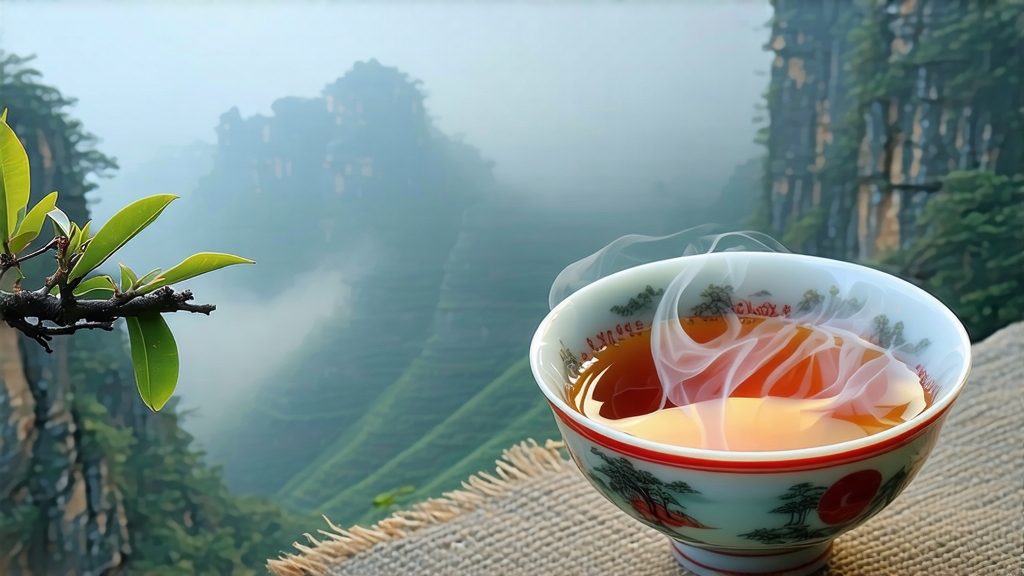
Wuyi Da Hong Pao—literally “Big Red Robe”—is the most storied oolong on earth, yet its name still sounds like myth to many Western drinkers. Born in the sheer crevices of northern Fujian’s Wuyi Mountains, this tea carries the scent of pine-smoke, the sweetness of longan, and the mineral pulse of ancient lava rock. To understand it is to step into a landscape where monks once draped their own crimson robes over six mother bushes to thank the tea that saved an emperor’s mother, and where modern artisans still wake before dawn to climb bamboo ladders lashed to thousand-foot cliffs.
History: From Imperial Tribute to Global Icon
The earliest written record appears in 1385, when Ming dynasty scholars noted “crimson-robed shoots thriving on Yunu Peak.” By 1600 the tea had become imperial tribute; caravans carried it north along the Mei-ling Pass, wrapped in silk and sealed with wax. In 1684 the Kangxi Emperor granted the six original bushes royal protection, a status they retain today under state guard. The 19th-century tea barons of Quanzhou shipped roasted Da Hong Pao to Singapore and San Francisco, but the Cultural Revolution halted production; the craft survived only because a handful of farmers hid charcoal kilns in remote caves. When China reopened, cuttings from the mother bushes were grafted onto lower-elevation stock, creating the “queen” and “common” grades that now satisfy global demand without plundering the ancient plants.
Terroir: The Cliff Gardens of Mount Wuyi
The 60-kilometre UNESCO World Heritage core zone is a petrified seabed thrust upward 400 million years ago. Purple-red rhyolite weathers into a shallow, gritty soil laced with quartz and feldspar; daytime temperatures on the cliffs can swing 15 °C within hours. Such stress forces the tea roots to forage deep, drawing calcium, magnesium and fluoride into the leaf. The result is yan yun—“rock rhyme”—a tactile finish that feels like licking wet stone, followed by a lingering hum of sweetness that Chinese tasters compare to the after-tone of a bronze bell.
Cultivars: Bloodlines of the Red Robe
True Da Hong Pao is not a single plant but a blend of four Wuyi cultivars, each contributing a voice to the chorus:
- Qi Dan – the closest genetic match to the mother bushes; lilac aroma, razor-sharp minerality.
- Bei Dou – cold-resistant, planted on north-facing ledges; gives cocoa depth.
- Que She – “sparrow-tongue,” a tiny-leaf clone that adds honeyed orchid top notes.
- Tieluohan – “Iron Arhat,” the muscular backbone that lengthens the finish.
Modern gardens also plant Dangui and Rougui for volume, but connoisseurs insist the classical quartet alone can weave the complex “rock rhyme.”
Craft: The Twelve Stages of Cliff Oolong
Plucking begins at dawn on the third or fourth day after the Grain Rain, when three half-mature leaves still carry the night’s dew. The baskets must be woven from bamboo harvested the previous winter; any resinous smell taints the leaf. Once down the mountain, the tea undergoes:
- Solar withering – spread on hemp cloth for 20 minutes to soften cell walls.
- Indoor withering – shaken every hour for 8–10 hours to bruise the edges, initiating oxidation.
- Heat shock – 280 °C wok-firing for 90 seconds to lock in 30 % oxidation, the sweet spot between green and black.
- Rolling – twisted on rattan mats until the leaf resembles a dark dragonfly wing.
- First roast – 100 °C for two hours in a bamboo drum over lychee-wood charcoal.
- Cooling – rested seven days to let residual moisture migrate outward.
- Second roast – 80 °C for four hours, repeated up to three times over three months.
Each roast lowers the water content by 3–4 %; the master judges readiness by pressing a leaf against his cheek, feeling for the coolness that signals inner balance. The final tea contains only 3 % moisture, allowing decades of graceful aging.
Grades: From Mother Bush to Market
- Mother